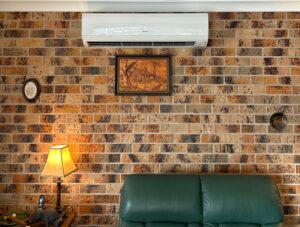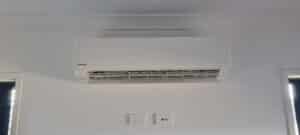Deciding between ducted and split systems for your Forster home hinges on specific needs. Ducted systems offer centralized climate control with consistent air distribution and advanced zoning, ideal for large homes but at higher costs and installation demands. They integrate well into your home’s design for a sleek look and quieter operation. In contrast, split systems are cost-effective, provide precise room control, and are flexible in placement, making them suitable for smaller spaces.
They may disrupt aesthetics with visible units but save on initial costs. Each system’s advantages and setup impact warrant a closer examination of your home’s requirements.
Key Takeaways
– Ducted systems suit large Forster homes, providing consistent and quiet climate control across multiple rooms.
– Split systems are ideal for smaller rooms, offering localized temperature adjustments and energy savings.
– Consider initial costs: ducted systems are pricier but offer comprehensive climate control, while split systems have lower upfront costs.
– Forster homes with limited ceiling space should opt for split systems due to easier installation.
– Both systems require regular maintenance for optimal performance and energy efficiency.
Overview of Ducted Systems
In the realm of home climate control, ducted systems offer a centralized solution that distributes conditioned air through a network of ducts, providing seamless temperature regulation across multiple rooms. This approach ensures consistent air distribution, eliminating the temperature disparities often experienced with localized units. Ducted systems are particularly advantageous if you value a quiet home environment. By housing the main air handling unit away from living spaces, they minimize noise levels significantly, ensuring a peaceful atmosphere.
Additionally, ducted systems excel in offering customization options. With advanced zoning capabilities, you can divide your home into distinct zones, each with individual temperature settings. This feature allows you to tailor the climate in different areas to suit specific preferences or occupancy patterns. You’re not just limited to a single temperature setting for the entire house; instead, you can achieve energy efficiency by heating or cooling only the occupied zones.
The integration of zoning also means enhanced energy management, as you can avoid unnecessary conditioning of unoccupied spaces. Overall, ducted systems provide a robust and flexible solution for comprehensive home temperature control, making them a compelling choice for those seeking both comfort and efficiency.
Overview of Split Systems
While ducted systems offer centralized climate control, split systems provide a more localized solution by installing individual air conditioning units in specific rooms, allowing for precise temperature adjustments tailored to each area’s needs. This flexibility means you can customize the cooling capacity to suit each room’s size and function, ensuring comfort without wasting energy.
The indoor unit placement is crucial for optimizing performance and can be strategically positioned on walls or ceilings to maximize air distribution and aesthetic appeal.
When considering split systems, it’s important to evaluate noise levels. The design typically separates the noisier components in the outdoor unit, minimizing indoor disturbance. This can be particularly beneficial for areas where quiet is essential, such as bedrooms or home offices.
However, the outdoor unit size can vary depending on the cooling capacity required, and space constraints should be considered to ensure it fits comfortably outside your home.
Split systems offer efficient cooling solutions with the added advantage of controlling individual room temperatures and reducing energy consumption. By understanding their components and capabilities, you can make an informed decision about whether this system aligns with your cooling needs in a Forster home.
Installation Considerations
When installing a ducted or split air conditioning system, ensure you assess the structural layout of your home to optimize unit placement and airflow efficiency.
Ducted systems require extensive planning due to their integration within your ceiling or walls. Consider the following installation challenges and space requirements:
1. Ducted Systems: These systems demand significant ceiling void space for ductwork, which mightn’t be feasible in homes with low clearance. Ensure there’s enough room for ducts and vents without compromising structural integrity. Additionally, the installation process can be invasive and time-consuming, requiring professional assistance.
2. Split Systems: These are more flexible in terms of placement and can be installed in individual rooms without impacting the entire home. However, you must ensure an appropriate outdoor location for the compressor unit, which should be accessible for maintenance yet unobtrusive.
3. Electrical and Structural Considerations: Both systems require adequate electrical supply and support structures. Ensure your home’s electrical capacity can handle the added load. Reinforce walls or ceilings if necessary to support the weight of the units, particularly with ducted systems.
Proper assessment and planning will mitigate installation challenges and ensure your chosen system meets your home’s space requirements.
Energy Efficiency Comparison
Choosing between ducted air conditioning and split systems hinges on understanding their energy efficiency, as each system consumes power differently based on design and operation.
Ducted systems offer centralized cooling, distributing air through ducts to maintain a consistent temperature throughout your home. However, they can lead to energy losses if the ductwork isn’t properly sealed or insulated, which could affect your energy savings and increase your environmental impact. These systems are generally more efficient in larger spaces, as they can cool the entire area with a single operation.
On the other hand, split systems provide targeted cooling, allowing you to adjust temperatures in specific zones. This zonal control can result in significant energy savings, as you can cool only occupied rooms, reducing unnecessary energy consumption. Moreover, modern split systems often feature inverter technology, which adjusts the compressor speed to maintain desired temperatures efficiently, reducing their environmental impact.
When comparing the two, consider your home’s size and layout. For larger homes, the centralized efficiency of ducted systems can be beneficial. In contrast, split systems might be more advantageous for smaller or multi-story homes where flexible zoning is key to maximizing energy efficiency and minimizing environmental impact.
Cost Analysis
In terms of cost analysis, you’ll need to consider both initial installation expenses and long-term operational costs to determine the more economical option between ducted air conditioning and split systems.
Let’s break it down:
1. Initial Investment: Ducted systems typically require a higher initial investment due to extensive ductwork and installation complexity. Split systems, on the other hand, often have lower upfront costs as they involve simpler installation processes and less equipment.
2. Operational Costs: Over the lifespan of the units, operational costs can vary significantly. Ducted systems may have higher energy consumption, especially if you’re cooling multiple rooms simultaneously. However, split systems allow for more targeted cooling, potentially reducing energy expenses by only cooling specific areas as needed.
3. Long-Term Savings: While ducted systems might offer comprehensive climate control, their initial investment and operational costs could outweigh potential long-term savings. Conversely, split systems, with lower initial costs and potentially reduced energy usage, might provide better long-term savings, albeit with some trade-offs in overall home cooling uniformity.
Ultimately, your choice should be informed by your specific cooling needs, budget constraints, and desired balance between initial expenditure and long-term savings.
Temperature Control Features
While evaluating cooling systems, understanding the temperature control features of ducted air conditioning and split systems is vital to ensure optimal comfort and efficiency.
Ducted air conditioning systems typically come with advanced smart thermostats that allow you to regulate the temperature across different zones in your home. These systems offer comprehensive zoning capabilities, enabling you to set distinct temperature preferences for various rooms. This feature not only enhances comfort by catering to individual preferences but also optimizes energy consumption by focusing cooling efforts on occupied areas.
On the other hand, split systems often provide individual controls for each indoor unit. This means each unit can be operated independently, allowing precise temperature adjustments in specific rooms without affecting the rest of the home. While split systems may not inherently offer integrated zoning capabilities like ducted systems, their inherent design facilitates a sort of decentralized control. The inclusion of smart thermostats can further enhance their functionality, allowing for remote temperature adjustments and scheduling.
Maintenance Requirements
Regular maintenance is crucial for both ducted air conditioning systems and split systems to ensure they operate efficiently and have a prolonged lifespan. Establishing a consistent cleaning schedule is essential, as it helps prevent dust build-up, which can lead to increased repair costs over time. Both systems demand attention to specific components, with a focus on filter maintenance and coil care.
Here’s a basic breakdown of maintenance tasks for each system:
1. Filter Maintenance: For both ducted and split systems, clean or replace filters every 1-3 months. Dirty filters reduce airflow, strain the system, and diminish efficiency.
2. Coil Care: Evaporator and condenser coils should be checked and cleaned annually. Dust and debris accumulation can impair heat absorption and increase energy consumption.
3. Professional Inspection: Schedule a professional inspection at least once a year. A technician can identify issues that mightn’t be apparent to the homeowner, potentially saving significant repair costs.
While ducted systems may have higher initial maintenance costs due to their complexity, split systems require regular attention to their outdoor units. Consistent maintenance ensures either system functions optimally, reducing the likelihood of unexpected breakdowns and extending the equipment’s service life.
Aesthetic Impact
Choosing between ducted air conditioning and split systems involves evaluating the aesthetic impact on your space. Ducted systems offer a sleek, hidden installation, while split systems require visible indoor units. Ducted systems integrate seamlessly into your home’s interior design, with vents discreetly positioned in ceilings or floors, preserving the clean lines and visual appeal of your space. This approach minimizes the visual clutter and helps maintain the architectural integrity of your home.
Split systems, on the other hand, feature wall-mounted units that can detract from the overall design aesthetic, potentially clashing with your interior elements.
In terms of noise levels and space utilization, ducted systems provide a quieter operation because the compressor is located outside, away from living areas. This setup also optimizes space utilization, as it doesn’t require additional wall space for indoor units.
Conversely, split systems may impact the landscaping around your property due to the need for an external unit. These systems can generate noticeable noise levels, particularly if multiple units are installed, which may interfere with the tranquillity of your living environment.
Ultimately, the choice depends on how much you value unobtrusive aesthetics and efficient use of your home’s space.
Ideal Applications
Ducted air conditioning systems are ideal for large homes and open-plan spaces, providing consistent climate control without the intrusion of visible units, while split systems excel in smaller, individual rooms where targeted cooling or heating is preferred.
When considering room size and climate suitability, ducted systems efficiently manage temperature across expansive areas, making them perfect for Forster’s varying climate. Conversely, split systems are tailored for specific rooms, allowing you to adjust settings based on individual preferences and needs.
In terms of noise levels and customization options, ducted systems have a central unit often installed away from living areas, minimizing noise disruption. This setup ensures a quiet and comfortable environment throughout your home.
Split systems, while generally quieter than older models, can still emit noticeable sound in the rooms they’re installed. However, they offer excellent customization options, enabling you to control the climate in each room separately.
Here’s a quick breakdown:
1. Room Size: Ducted systems for large, open areas; split systems for smaller rooms.
2. Climate Suitability: Ducted for consistent control; split for targeted comfort.
3. Noise Levels & Customization: Ducted for quieter operation; split for individual control.
Frequently Asked Questions
Can Ducted Systems Be Zoned for Different Rooms?
Yes, you can zone ducted systems for different rooms, offering zoning flexibility. This enhances energy efficiency by cooling only selected areas. However, consider the installation costs and maintenance requirements, which can vary depending on your specific setup.
How Noisy Are Ducted Air Conditioning Systems Compared to Split Systems?
You’re considering noise levels and energy efficiency. Ducted systems are generally quieter since the noise-producing components are distant. However, split systems can be noisier inside. Both systems offer varying energy efficiency depending on their design and usage.
Do Split Systems Improve Air Quality in Homes?
Split systems can improve indoor air quality, offering health benefits by filtering dust and allergens. They’re energy-efficient, but consider installation costs and ongoing maintenance requirements to ensure optimal performance. Regular filter cleaning enhances their efficiency and longevity.
Can Both Systems Be Integrated With Smart Home Technology?
You can integrate both ducted and split systems with smart home technology, enhancing energy efficiency. Consider the installation process, cost comparison, and maintenance requirements to determine the most suitable option for seamless integration with your smart home setup.
How Do Ducted and Split Systems Affect Home Resale Value?
Considering home resale value, ducted systems often enhance design aesthetics but have higher installation costs. Split systems offer flexible energy efficiency impact and lower maintenance requirements. Both systems can attract buyers depending on their preferences and budgets.
Conclusion
When choosing between ducted and split systems for your Forster home, consider your specific needs.
Ducted systems offer seamless temperature control across multiple rooms, while split systems provide flexibility for individual spaces.
Installation complexity and costs vary, with ducted systems generally requiring a larger upfront investment.
Both systems have unique maintenance needs and energy efficiencies.
Ultimately, your decision should balance initial costs, long-term savings, aesthetic preferences, and the specific climate control requirements of your home.



